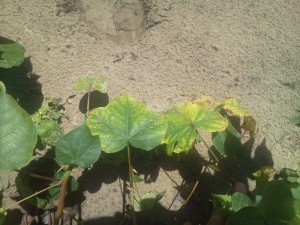We have been blessed with rainfall this spring throughout North Florida, and it has ensured excellent stands in our planted crops and kept our crops free from moisture stress. In most cases the amount of rainfall hasn’t overwhelmed our sandy soils, but has certainly created some inconveniences. It has also created a few challenges in managing plant nutrients in our cotton crops especially on our deep sandy soils and those without a poultry litter history.
Lately, I have been watching our cotton crop get more pale with each passing rain. Because of the likelihood of nitrogen to leach from our soils, the University of Florida suggests 30 lbs of additional nitrogen for each leaching rainfall event. Fortunately, cotton is one of the more forgiving crops we grow with a low nitrogen requirement and a deep taproot. I obtained rainfall data for several weather stations in the Suwannee Valley for the period June 3 to July 10, 2013. The rainfall totals are shown in the table below. What isn’t shown is what we recommend as a leaching rainfall event: Greater than 3″ in 3 days or 4″ in 7 days. I did not have time to analyze every weather station, but the SVAEC station at Live Oak/Wellborn had 4 seperate seven day periods with over 4″ of rain during this period.
| Rainfall June 3 – July 10, 2013 | |||||
| OLENO | BELL TOWER | SVAEC/Wellborn | ALAPAHA TOWER | MADISON BLUE | SNEADS |
| 14.52 | 14.4 | 15.72 | 12.42 | 16.72 | 12.35 |
All of our cotton farmers have recieved different rainfall quantities than these, and there is a wide range of planting and fertilization dates. However, I have suggested that each of them consider a supplemental fertilization of 30 lbs of nitrogen and 20-30 lbs of potash if they have recieved these leaching rainfall events on their fields after their fertilizer was applied. We know that cotton has a large potassium demand, reaching 3.0 lbs per acre per day at peak bloom. It is important to correct deficiencies of nitrogen and potassium by the third week of bloom.

